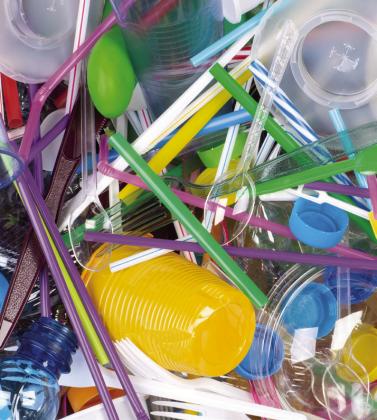WHEN I WAS a little girl, I thought the invention of the facial tissue was one of the best advancements ever! It was much more sanitary to cover my cough or sneeze using a soft piece of a disposable tissue than to use cloth handkerchiefs, which had to be laundered and reused. Ick! Tissues were much more sanitary since you used them once and threw them away. Today, a single-use plastic item replaces everyday items the same way as the tissue. Things we used years ago—glasses, silverware, bottles. and more—have been replaced by plastic. Again, they are sanitary and convenient. Most of my experience with single-use plastics started in the medical arena, doctor’s offices, rehab offices, hospitals, and clinics. Moving forward several decades, I continued to appreciate one-timeuse plastics like straws, plastic pill containers, plastic cups that contained my dose of medications, water for taking the medications, and plastic covers for my injectable medications. Many syringes could contain plastics, and came in plastic bags that were disposed of. The biggest thing I liked about these items was the fact that they were so sanitary and could be thrown away after you used them. So, we use single-use plastics (SUPs). They are so convenient! Why should we watch our use of them? Why is it harmful?
And then I learned the other side of single-use plastics. The plastic typically used in bottles, bags, and food containers contains chemical additives such as endocrine disruptors, which are associated with negative health effects including cancers, birth defects, and immune system suppression in humans and wildlife. Sister Rosine Sobczak, Associate Professor Emerita from the Biology Department at Lourdes University, and Co-founder and President of S.A.V.E. (Science Alliance for Valuing the Environment), offers some insights. She explains that SUPs are used once or for a very short time and then thrown away in our trash. What do they do to our planet? First of all, these plastics can eventually affect our health. They are put in our trash and eventually clutter our landfills where they pollute water, land, and air with harmful chemicals. They are made from a variety of petrochemicals, some which are also harmful. Some plastics can be recycled but not all. They find their way into rivers, streams, and oceans as marine litter to be ingested by water- loving creatures that are unable to digest them and later die from them. (Straws, plastic rings, and plastic bags are culprits along with many other items.) These items wash up on beaches in other coastal countries as floating mats of plastic garbage to clutter other people’s lifestyles and affect their healthy living with dangerous chemicals.
The fact that plastics bombard our Earth can make us feel overwhelmed and helpless. Gradually, when the residents of this planet decide to save our creatures—and humans are definitely included—we can start by doing something to help. It’s good to remember that we can’t do everything or lots of large things. But it should give us some hope and comfort to know that we can do something, however little, to do our part. Each of us doing something can certainly add up to make a dent.
Here are a few things Sister Rosine says we each can try:
• When grocery shopping select your product if it does not use plastic packaging. This may be possible for some foods but not all.
• When going through a drivethrough for a food pickup, ask the employee to remove the straw(s) and plastic cutlery from your bag.
• When dining out, feel free to ask the wait staff not to bring straws. You are saving the
n planet one straw at a time.
• Use the plastic straw again at home and multiple times.
• Take cloth bags to the grocery store to package your foods or use the self-checkout. In either case, you will have to package your own groceries, but it is a small way to save Earth from pollution and requires just a little of your time.
• Buy groceries from a store that uses compostable bags or paper bags. These will break down in the environment sooner than a plastic bag that scientists estimate will take 1,000 years.
• Take your plastic bags to the grocery store. Some have recycling containers for this purpose located inside the store.
• Reuse plastic containers for freezing food items or storing food in your refrigerator instead of using Ziploc or other plastic bags. You can keep the container longer and have less trash to go to the landfill.
• Take a plastic container inside a restaurant or a gathering to take home leftovers.
The more we do some or all of these things, the sooner they’ll become common practice, which will help eliminate climate change by keeping harmful chemicals out of the environment one little thing at a time!
Sister Karen Zielinski is the Director of Canticle Studio. Canticle Studio is a part of the Sisters of St. Francis of Sylvania, OH’s overall advancement effort and has a mission of being a creative center where artists generate works, products, and services in harmony with the mission of the Sisters St. Francis. She can be reached at kzielins@sistersosf.org or 419-824-3543. ✲


